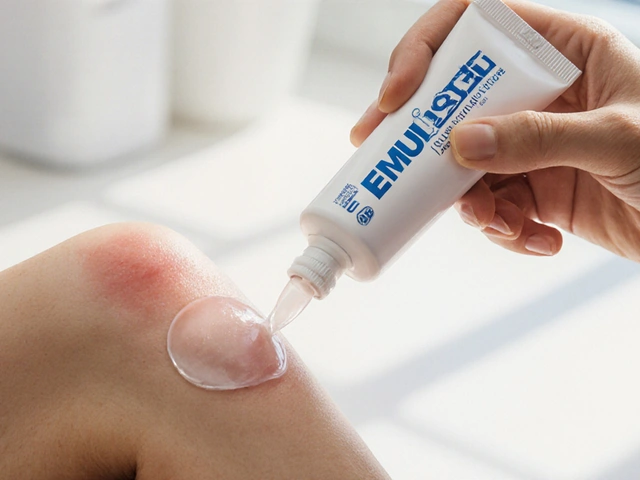Prednisone: Necessary Evil or Obsolete?
Prednisone is a heavy hitter in the world of inflammation. Whether you've got rheumatoid arthritis, lupus, asthma, or something else simmering in the immune system, prednisone can be your magic bullet—or your worst enemy. If you've ever felt the wild swings between relief and frustration on this steroid, you're far from alone. The pill works, but the side effects can make you feel like you're caught in a bad loop: think swelling, insomnia, bone loss, moon face, weight gain, and mood swings that make you wonder if you woke up in someone else's body. Plus, long-term use straight-up puts you at real risk of diabetes, infections, and brittle bones. But what if you could swap out the steroid and hold down the inflammation without the chaos? That’s where steroid-sparing strategies come into play. Newer treatments and some time-tested immune suppressors can keep the flames low and your body running smoother. Doctors today have several non-steroid options that may even outperform prednisone in the long haul. That’s right—medicine has been quietly moving forward, and if you haven’t taken a fresh look at prednisone alternatives, you might be missing out on something way better.
The Old Guard: Methotrexate and Azathioprine
Let’s be real: methotrexate and azathioprine aren’t exactly new kids on the block. They’ve been around for decades, but their resumes keep getting stronger. Methotrexate started life as a cancer drug but quickly built a second career in rheumatology—nobody’s favorite pill, but it sure gets respect. It’s now the gold standard for rheumatoid arthritis, beating prednisone at its own game for many people. In a massive 2022 review, patients saw better joint protection and way fewer long-term complications on methotrexate than on high-dose steroids. Typical dose? Just 7.5 to 25mg once a week, and it’s often paired with folic acid to curb side effects. Main gripes are stomach upset and tiredness, but liver checks keep things safe. Meanwhile, azathioprine quietly holds down the fort for autoimmune diseases from lupus to Crohn’s. It works by tamping down overzealous white blood cells. Studies show that for people with inflammatory bowel disease or kidney inflammation from lupus, azathioprine does almost as well as prednisone at putting out the fire—without trashing your bones or immune defenses. Side effects with azathioprine do pop up, like low blood counts or occasional liver issues, so folks need labs checked every month. But given the hazards of steroids, most would call it a fair trade.

Biologics: Tomorrow’s Medicine Today
This is where things get futuristic. Biologics are lab-made marvels that target the exact troublemaker chemicals behind your inflammation—think of them like snipers instead of sledgehammers. They include meds like adalimumab (Humira), etanercept (Enbrel), infliximab (Remicade), and rituximab (Rituxan). These drugs have literally changed the game for arthritis, inflammatory bowel disease, and even some types of vasculitis. Instead of shutting down your entire immune system, they silence one bad actor at a time. Take rheumatoid arthritis again: a 2023 meta-analysis out of Stanford compared biologics with prednisone and showed patients on adalimumab had 43% greater reduction in joint swelling and pain, plus a 50% lower risk of future joint damage. Not only do you skip most steroid side effects, you may actually keep your bones strong and your blood sugar steady. Biologics can be pricey and usually need either injections or infusions every few weeks, but insurance in the U.S. is catching up—and most drug makers run pretty good assistance programs. The biggest curveball? Biologics do raise your risk for some infections, so most doctors check for tuberculosis and hepatitis before you start.
Other Key Players: Mycophenolate, Leflunomide, and Newcomers
If you thought that was all, think again. Mycophenolate mofetil is another workhorse for lupus and severe kidney inflammation. It’s shown almost identical remission rates to prednisone (up to 70% for lupus nephritis in a Johns Hopkins cohort from 2023) with much less risk of steroid diabetes. Side effects tend to focus on stomach and immune suppression—but for some patients, the steroid-sparing benefits are hard to beat. Leflunomide, often prescribed for rheumatoid arthritis, works by jamming signals in killer immune cells. A 2024 study from Cleveland Clinic saw patients on leflunomide needing about half as much emergency steroid ‘rescue’ over a year compared to those on methotrexate. And then there’s tofacitinib and upadacitinib, new oral options called JAK inhibitors, which interrupt inflammation way upstream. People looking for a pill instead of an injection find these especially appealing. Real-world data with JAK inhibitors shows rapid relief for many, though monitoring for blood counts and cholesterol is part of the deal. Want a full run-down comparing side effects, dosing, and costs between these options? This deep-dive into prednisone alternatives does a great job laying out what works and what to watch out for.

How to Talk to Your Doctor: Tips to Make the Switch
So what’s the secret sauce to getting off prednisone—or at least dialing it down? Honest, ongoing talk with your doctor is step one. Most specialists agree that dropping your steroid dose slowly (think weeks, not days) is key to avoiding an abrupt flare, and using a steroid-sparing agent as a bridge is the safest way out. Here’s a tip: if you’ve only been on prednisone for a brief period, your body adjusts faster, but for long-term users, a “custom taper” is non-negotiable. Labs for liver, kidneys, and blood counts are more than just busywork—they help spot trouble before it knocks you off your game. Keeping a symptom journal can expose triggers and show progress over time. Don’t skip vaccines (especially flu and pneumonia), since your immune system precision-tuners can make you more prone to bugs. And if your doc recommends bone protection (like vitamin D, calcium, or even a bone density scan), it’s worth listening: about 1 in 4 patients on long-term steroids suffer a fracture, but prevention plans really do help. Ask about assistance programs or generic options—cost shouldn’t be what stands between you and feeling better. And sometimes, a mix-and-match approach works out best, dialing in one med’s upsides to cover another’s weak spot. Keep an open mind, measure progress in months not days, and don’t be afraid to revisit your plan as the science keeps evolving.






12 Comments
Aaron Miller
May 4, 2025 AT 13:06 PMPrednisone is just the crutch of a weak medical establishment!!!
Roshin Ramakrishnan
May 9, 2025 AT 17:28 PMFriends, let’s remember that every therapeutic advance has its own story; the journey from prednisone to methotrexate, azathioprine, or biologics is a testament to collaborative science, patient perseverance, and compassionate care-never forget to share your experiences, celebrate small victories, and support each other throughout the transition!
Todd Peeples
May 14, 2025 AT 21:50 PMFrom a pharmacological epistemology standpoint, the paradigm shift toward targeted immunomodulators underscores the mechanistic specificity of cytokine inhibition (e.g., TNF‑α blockade) and the resultant attenuation of downstream osteoclastic activity; such precision therapeutics mitigate iatrogenic sequelae while preserving homeostatic integrity. 🔬📈
Chris Smith
May 20, 2025 AT 02:12 AMOh great, another list of pills that cost more than your rent.
Leonard Greenhall
May 25, 2025 AT 06:34 AMThe statement contains a logical fallacy; cost does not inherently diminish therapeutic efficacy, especially when clinical endpoints demonstrate superior disease control relative to corticosteroids.
Abigail Brown
May 30, 2025 AT 10:56 AMThe steroid‑sparing revolution is nothing short of a lifeline for countless patients; it represents the culmination of decades of research, trial, and error.
When you compare long‑term bone density loss from prednisone with the relatively benign hepatic monitoring required for methotrexate, the benefits become starkly evident.
Biologics, once the domain of affluent clinics, are now entering mainstream formularies thanks to aggressive biosimilar competition.
Patients who once dreaded the inevitable moon‑face are now able to maintain a more natural appearance while still achieving remission.
Moreover, the reduction in opportunistic infections associated with high‑dose steroids translates into fewer hospitalizations and lower overall healthcare costs.
Even JAK inhibitors, despite their oral convenience, have shown comparable efficacy in rheumatoid arthritis without the severe cortisol‑related metabolic derangements.
The data from the 2023 Stanford meta‑analysis alone underscore a 43% greater reduction in joint swelling for adalimumab versus prednisone.
That is a game‑changing statistic for anyone living with chronic pain.
Of course, clinicians must remain vigilant about screening for latent TB and hepatitis before initiating biologics, but those are manageable protocols.
Patients should also be educated about the importance of regular lab work, especially liver enzymes on methotrexate and complete blood counts on azathioprine.
Education empowers the individual to spot early warning signs before catastrophic outcomes occur.
Insurance assistance programs have dramatically improved access, turning what once seemed financially impossible into a realistic option for many.
In practice, a hybrid approach-using a low‑dose steroid taper while starting a DMARD-offers the safest pathway to remission.
The key is communication: doctors, pharmacists, and patients must collaborate openly.
Ultimately, the goal is to replace the blunt instrument of prednisone with precision tools that respect the body’s delicate balance.
Crystal Slininger
June 4, 2025 AT 15:17 PMWhile the above overview sounds convincing, let’s not forget that many of these “alternatives” are deliberately marketed by big pharma to keep patients dependent on expensive patents; the real truth is that lifestyle modifications and low‑dose steroid bursts can be just as effective without the hidden agenda.
Sumeet Kumar
June 9, 2025 AT 19:39 PMGreat summary! 😊 Remember to keep a symptom diary and bring it to every appointment – it really helps your doctor fine‑tune the regimen.
Maribeth Cory
June 15, 2025 AT 00:01 AMAbsolutely! Tracking your progress not only empowers you but also provides concrete data that can justify insurance approvals for newer therapies.
andrea mascarenas
June 20, 2025 AT 04:23 AMGood point about insurance; many patients overlook the assistance programs that can cut out‑of‑pocket costs dramatically.
Vince D
June 25, 2025 AT 08:45 AMExactly, those programs are a game‑changer.
Camille Ramsey
June 30, 2025 AT 13:06 PMPeople keep forgetting that you cant just swap drugs without proper tapering; it’s not rocket science but the internet makes it sound easy!!!